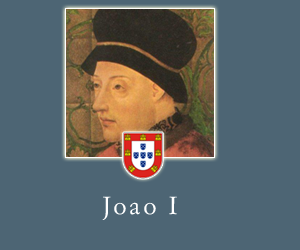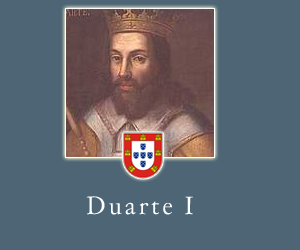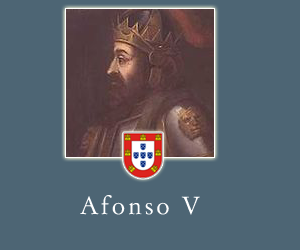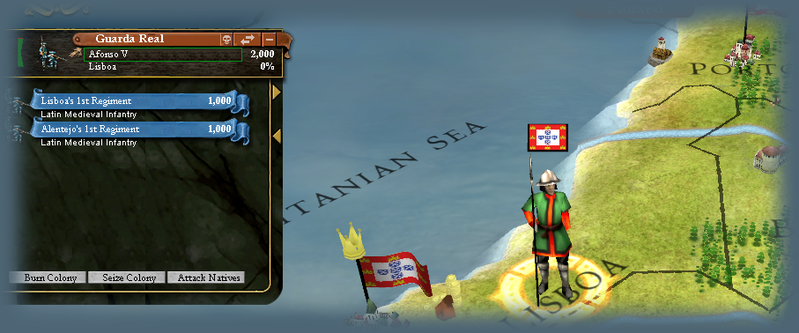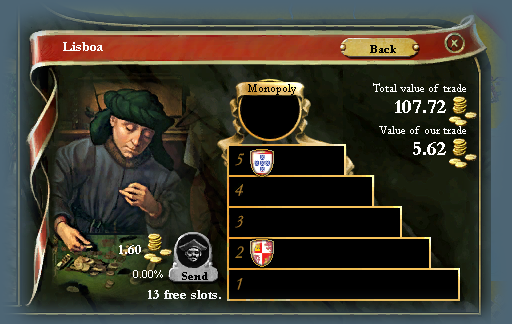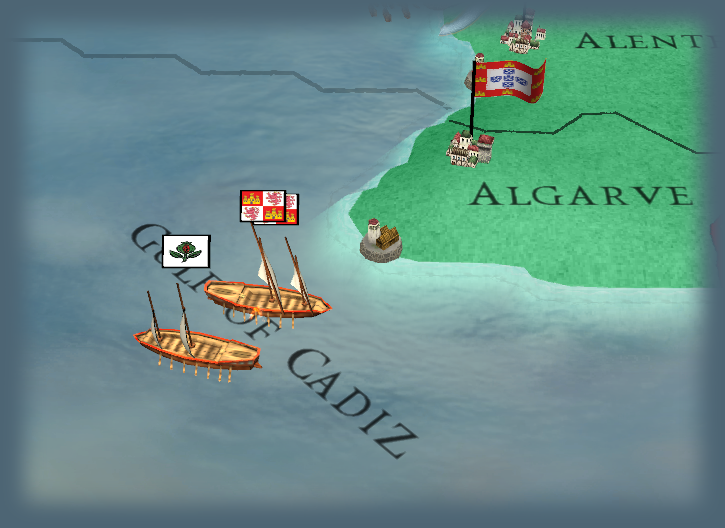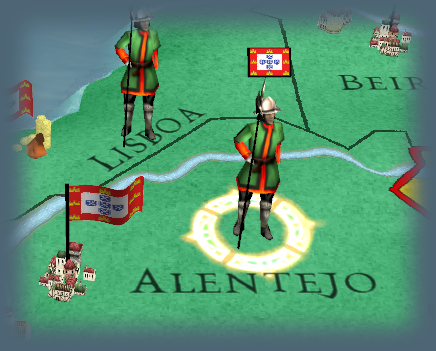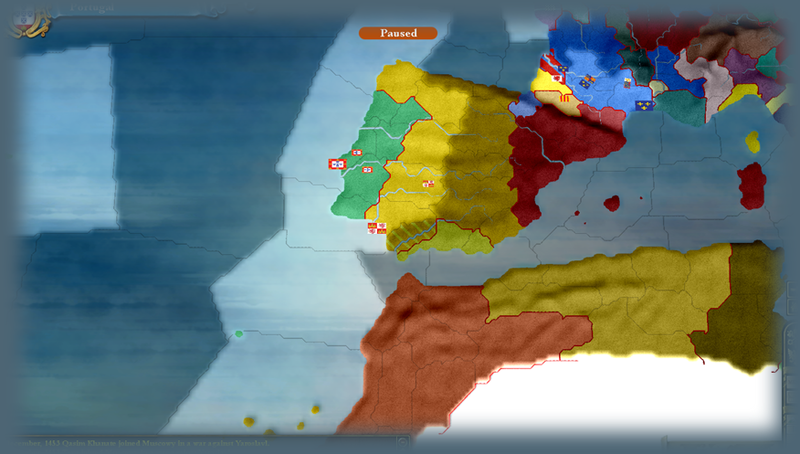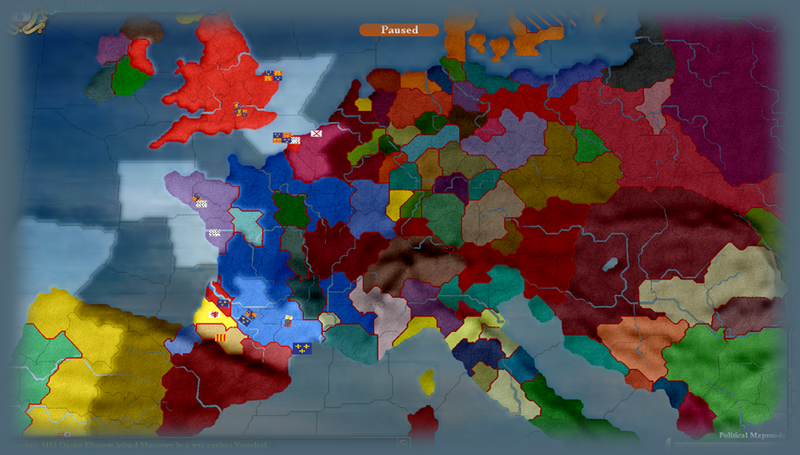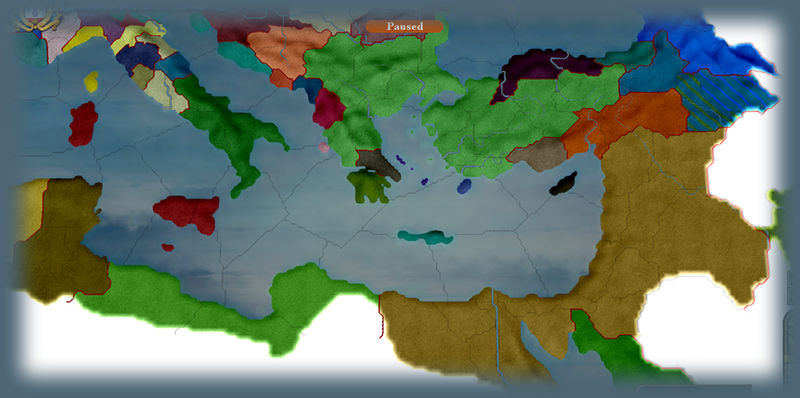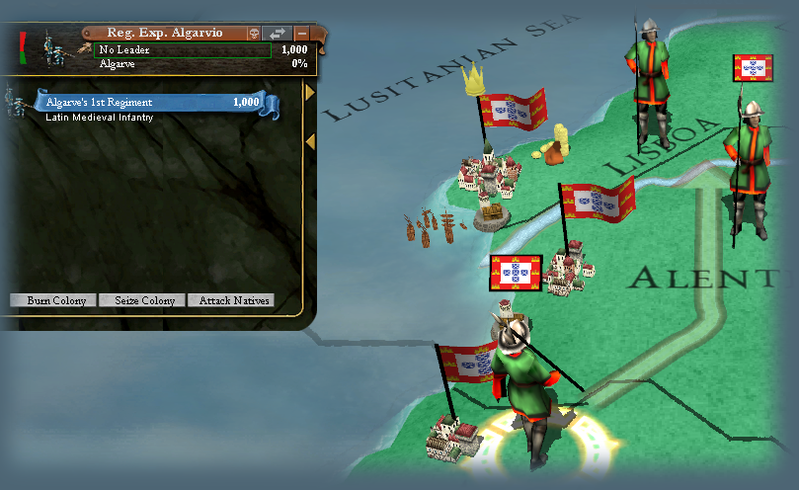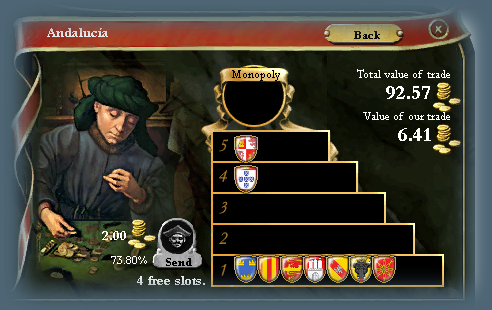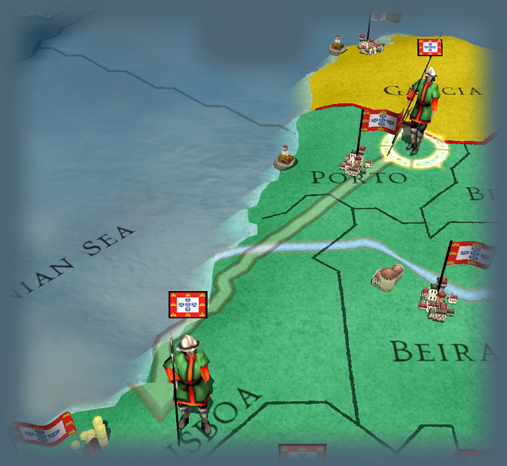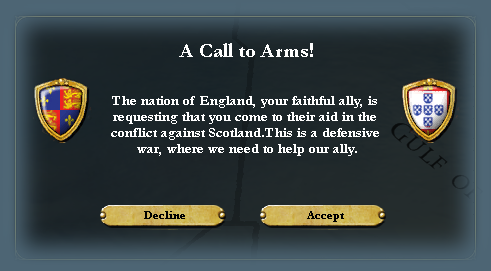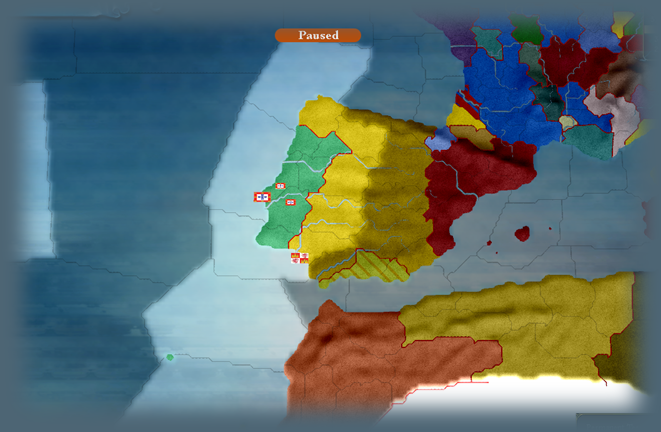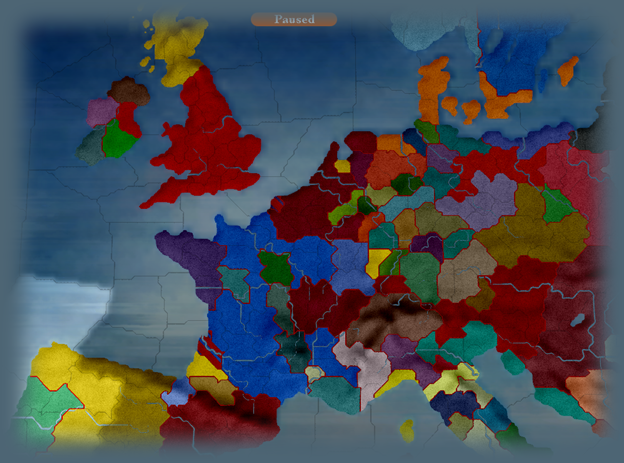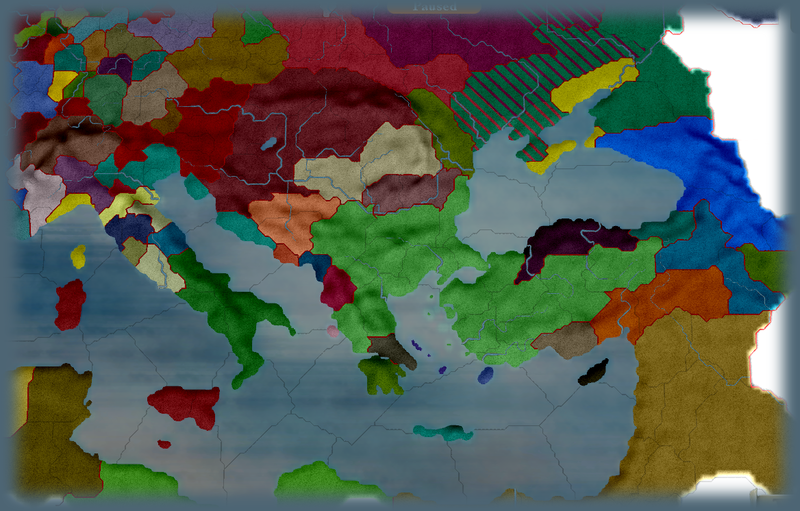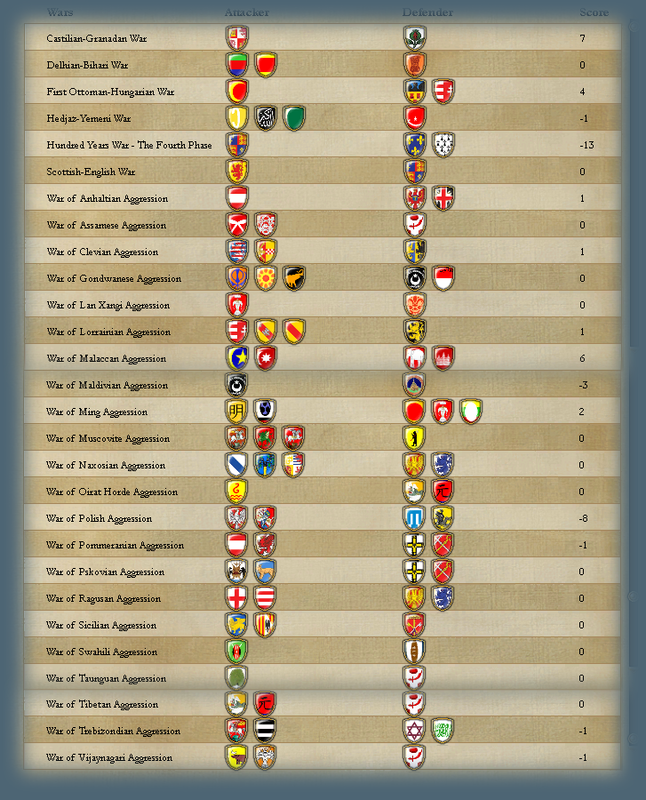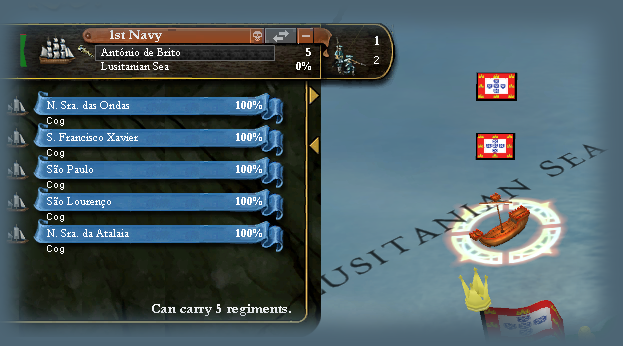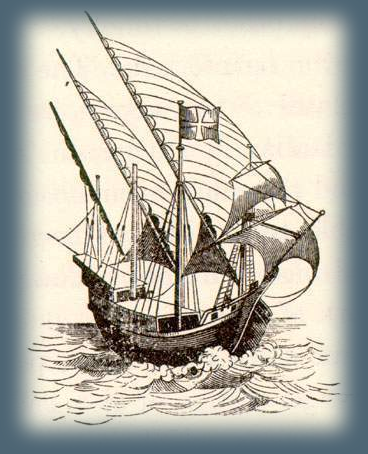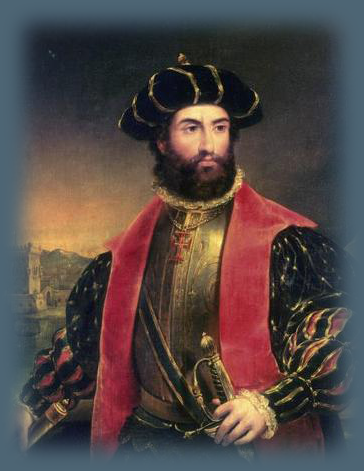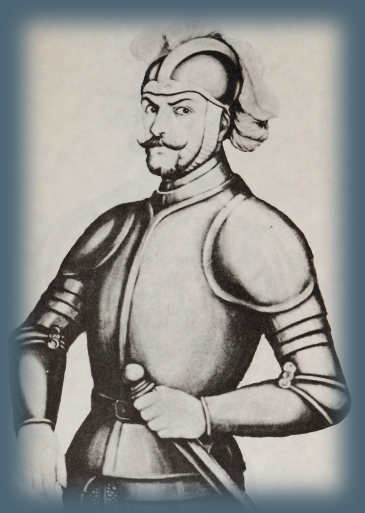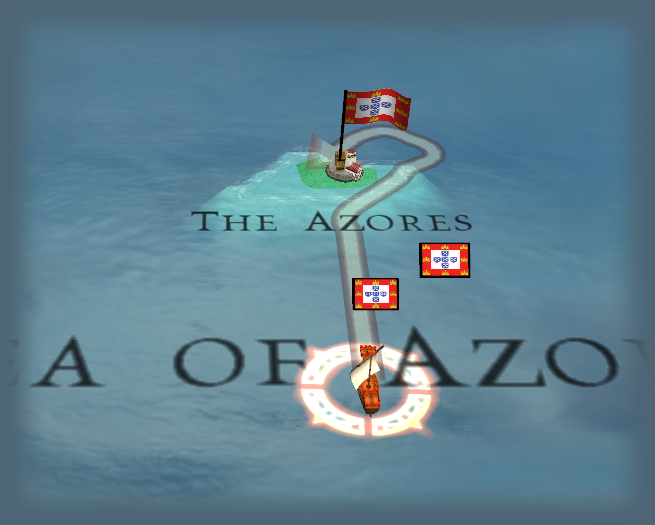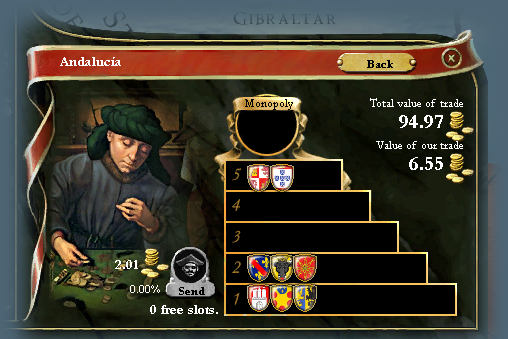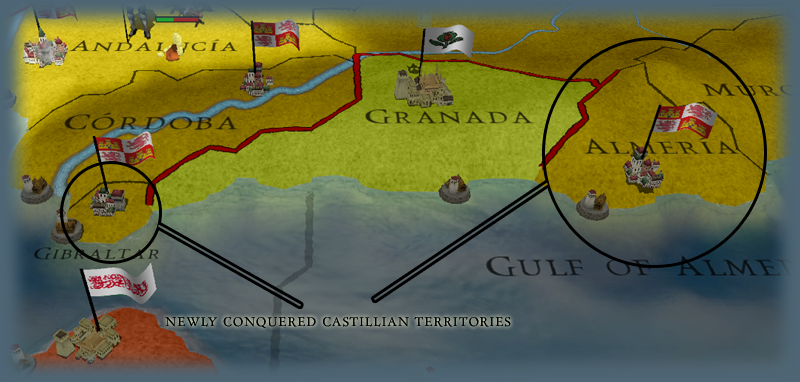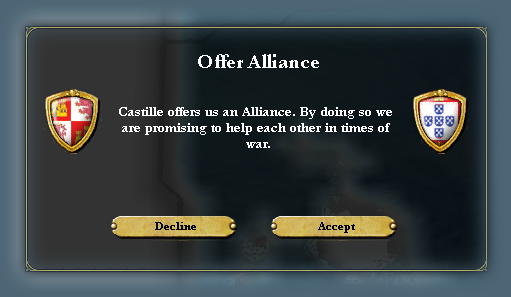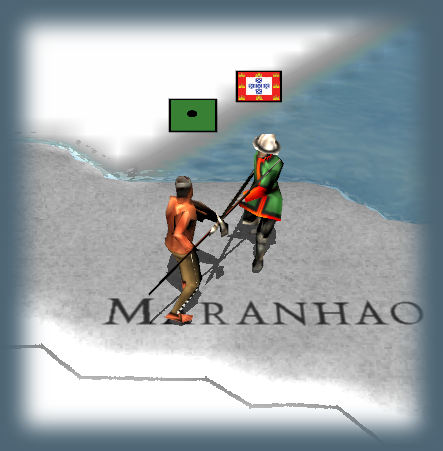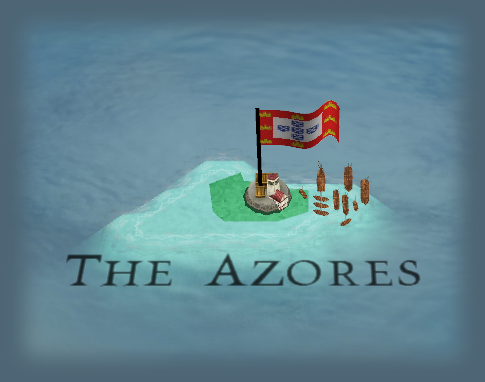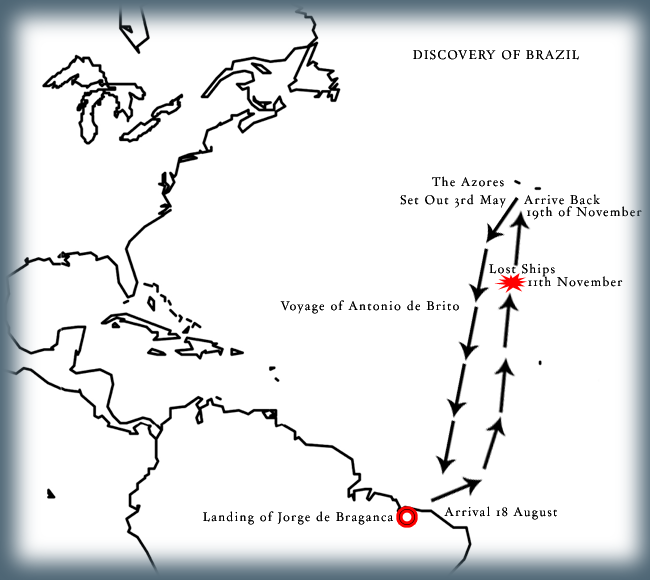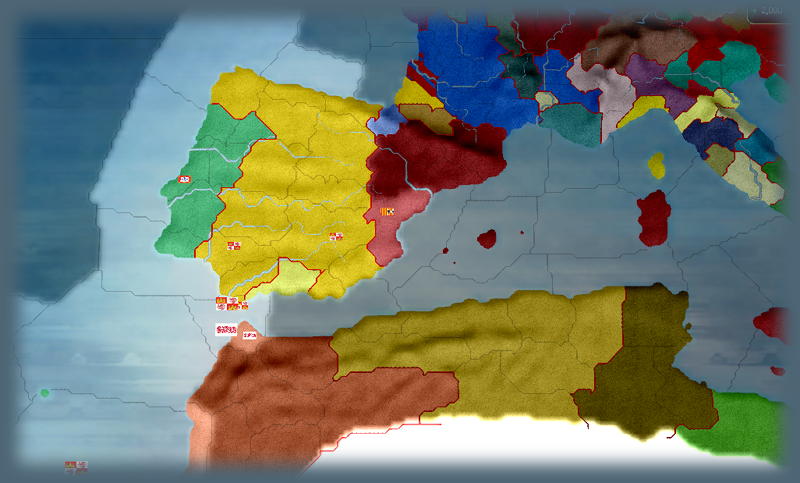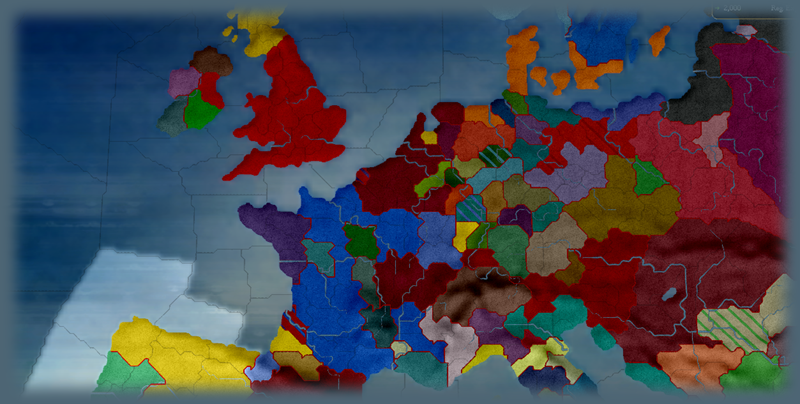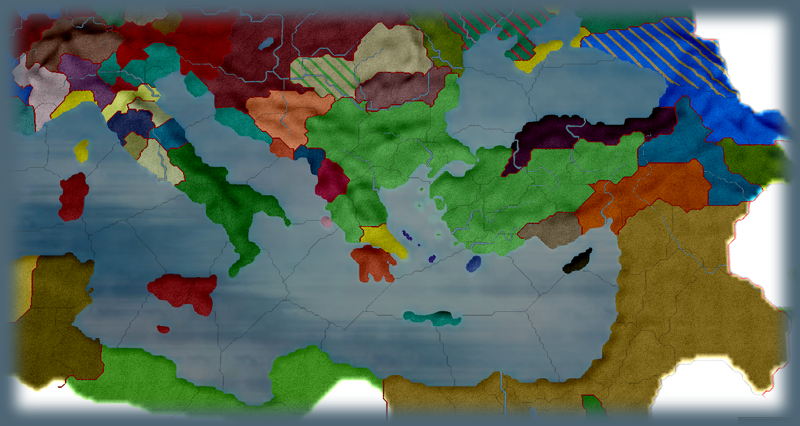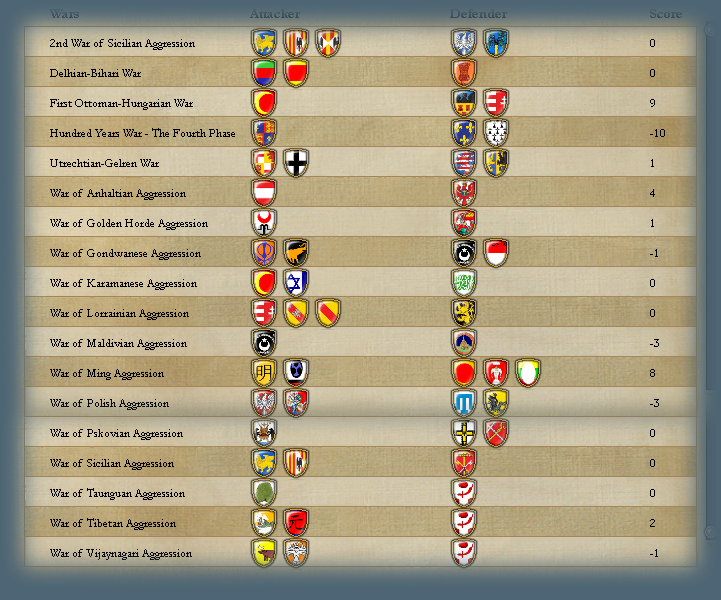Portugal: A Lusitanian Story
Format
The story will take the format of a historical document. Some events will be made up by me to justify a certain course of action but all will be told via the medium of an account of history.
Rules
1. Not allowed to take more than one loan, unless forced to for whatever reason. This means that I can knowingly take one loan.
2. No offensive military action can take place without a general or admiral (conquistador or explorer) in command of the fleet. I can however defend myself with no commander, if attacked by another nation. This extends to the fact that my army may not go onto foreign lands without a general in command of the army and therefore should my general be killed during a battle they will have to return to home lands to receive a new general or defend themselves from an approaching hostile army. In the case of sea warfare. I will not knowingly go into war without an Admiral in charge of the particular fleet but obviously if I am attacked without an admiral this is allowed. (NB: I may have to change this when I have many small armies as may be required. What I will make sure is that I have a general in charge of at least the largest regiment in an assault. And will try and have the generals in charge of other regiments. It may be impossible when I have very small armies detachments)
3. I will ensure that I am a good Christian and be an enemy of all Muslim, Pagan and Non believer countries. I am not allowed to ally to non Christian countries.
Prologue – Portugal before 1453: A History of Portugal through the men that ruled her
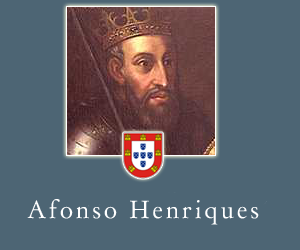
AFONSO HENRIQUES (1139 – 1185)
At the end of the 11th century, the Iberian Peninsula political agenda was mostly concerned with the Reconquista, the driving out of the Muslim successor-states to the Caliphate of Cordoba after its collapse. With European military aristocracies focused on the Crusades, Alfonso VI called for the help of the French nobility to deal with the Moors. In exchange, he was to give the hands of his daughters in wedlock to the leaders of the expedition and bestow royal privileges to the others. Thus, the royal heiress Urraca of Castile wedded Raymond of Burgundy, younger son of the Count of Burgundy, and her half-sister, princess Teresa of León, wedded his cousin, another French crusader, Henry of Burgundy, younger brother of the Duke of Burgundy. Henry was made Count of Portugal, a burdensome county south of Galicia, where Moorish incursions and attacks were to be expected. With his wife Teresa as co-ruler of Portugal, Henry withstood the ordeal and held the lands for his father-in-law.
From this wedlock several sons were born, but only one, Afonso Henriques (meaning "Afonso son of Henry") thrived. The boy, probably born around 1109, followed his father as Count of Portugal in 1112, under the tutelage of his mother. The relations between Teresa and her son Afonso proved difficult. Only eleven years old, Afonso already had his own political ideas, greatly different from his mother's. In 1120, the young prince took the side of the archbishop of Braga, a political foe of Teresa, and both were exiled by her orders. Afonso spent the next years away from his own county, under the watch of the bishop. In 1122 Afonso became fourteen, the adult age in the 12th century. He made himself a knight on his own account in the Cathedral of Zamora, raised an army, and proceeded to take control of his lands. Near Guimarães, at the Battle of São Mamede (1128) he overcame the troops under his mother's lover and ally Count Fernando Peres de Trava of Galicia, making her his prisoner and exiling her forever to a monastery in León. Thus the possibility of incorporating Portugal into a Kingdom of Galicia was eliminated and Afonso become sole ruler (Duke of Portugal) after demands for independence from the county's people, church and nobles. He also vanquished Alfonso VII of Castile and León, another of his mother's allies, and thus freed the county from political dependence on the crown of León and Castile. On April 6, 1129, Afonso Henriques dictated the writ in which he proclaimed himself Prince of Portugal.
Afonso then turned his arms against the persistent problem of the Moors in the south. His campaigns were successful and, on July 26, 1139, he obtained an overwhelming victory in the Battle of Ourique, and straight after was unanimously proclaimed King of Portugal by his soldiers. This meant that Portugal was no longer a vassal county of León-Castile, but an independent kingdom in its own right. That he then convened the first assembly of the estates-general at Lamego (wherein he would have been given the crown from the Archbishop of Braga, to confirm the independence) is likely to be a 17th century embellishment of Portuguese history.
Independence, however, was not a thing a land could choose on its own. Portugal still had to be acknowledged by the neighbouring lands and, most importantly, by the Roman Catholic Church and the Pope. Afonso wed Mafalda of Savoy, daughter of Count Amadeo III of Savoy, and sent Ambassadors to Rome to negotiate with the Pope. In Portugal, he built several monasteries and convents and bestowed important privileges to religious orders. In 1143, he wrote to Pope Innocent II to declare himself and the kingdom servants of the Church, swearing to pursue driving the Moors out of the Iberian Peninsula. Bypassing any king of Castile or León, Afonso declared himself the direct liegeman of the Papacy. Thus, Afonso continued to distinguish himself by his exploits against the Moors, from whom he wrested Santarém and Lisbon in 1147. He also conquered an important part of the land south of the Tagus River, although this was lost again to the Moors in the following years.
Meanwhile, King Alfonso VII of Castile (Afonso's cousin) regarded the independent ruler of Portugal as nothing but a rebel. Conflict between the two was constant and bitter in the following years. Afonso became involved in a war, taking the side of the Aragonese king, an enemy of Castile. To ensure the alliance, his son Sancho was engaged to Dulce Berenguer, sister of the Count of Barcelona, and princess of Aragon. Finally, in 1143, the Treaty of Zamora established peace between the cousins and the recognition by the Kingdom of Castile and León that Portugal was an independent kingdom.
In 1169, Afonso was disabled in an engagement near Badajoz by a fall from his horse, and made prisoner by the soldiers of the king of León. Portugal was obliged to surrender as his ransom almost all the conquests Afonso had made in Galicia in the previous years.
In 1179 the privileges and favours given to the Roman Catholic Church were compensated. In the papal bull Manifestis Probatum, Pope Alexander III acknowledged Afonso as King and Portugal as an independent land with the right to conquer lands from the Moors. With this papal blessing, Portugal was at last secured as a country and safe from any Castilian attempts at annexation.
In 1184, in spite of his great age, he still had sufficient energy to relieve his son Sancho, who was besieged in Santarém by the Moors. He died shortly after, on December 6, 1185.
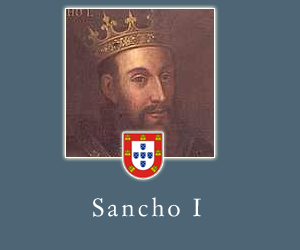
SANCHO I (REIGN 1185 – 1211)
With the death of Afonso I in 1185, Sancho I became the second king of Portugal. Coimbra was the centre of his kingdom; Sancho terminated the exhausting and generally pointless wars against his neighbours for control of the Galician borderlands. Instead, he turned all his attentions to the south, towards the Moorish small kingdoms (called taifas) that still thrived. With Crusader help he took Silves in 1191. Silves was an important city of the South, an administrative and commercial town with population estimates around 20,000 people. Sancho ordered the fortification of the city and built a castle. However, military attention soon had to be turned again to the North, where León and Castile threatened again the Portuguese borders. Silves was again lost to the Moors. It should be noted that the global Muslim population had climbed to about 6 per cent as against the Christian population of 12 per cent by 1200.
Sancho I dedicated much of his reign to political and administrative organization of the new kingdom. He accumulated a national treasure, supported new industries and the middle class of merchants. Moreover, he created several new towns and villages (like Guarda in 1199) and took great care in populating remote areas in the northern Christian regions of Portugal, notably with Flemings and Burgundians – hence the nickname "the Populator". The king was also known for his love of knowledge and literature. Sancho I wrote several books of poems and used the royal treasure to send Portuguese students to European universities.
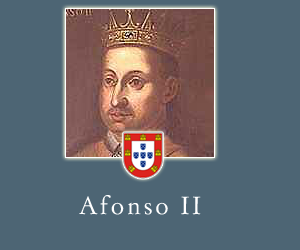
AFONSO II (REIGN 1212-1223)
As a king, Afonso II set a different approach of government. Hitherto, his father Sancho I and his grandfather Afonso I, were mostly concerned with military issues either against the neighbouring Kingdom of Castile or against the Moorish lands in the south. Afonso did not pursue territory enlargement policies and managed to insure peace with Castile during his reign. Despite this, some towns, like Alcácer do Sal in 1217, were conquered from the Moors by the private initiative of noblemen. This does not mean that he was a weak or somehow a cowardly man. The first years of his reign were marked instead by internal disturbances between Afonso and his brothers and sisters. The king managed to keep security within Portuguese borders only by outlawing and exiling his kin.
Since military issues were not a government priority, Afonso established the state's administration and centralized power on himself. He designed the first set of Portuguese written laws. These were mainly concerned with private property, civil justice, and minting. Afonso also sent ambassadors to European kingdoms outside the Iberian Peninsula and began amiable commercial relations with most of them.
Other reforms included the always delicate matters with the pope. In order to get the independence of Portugal recognized by Rome, his grandfather, Afonso I, had to legislate an enormous amount of privileges to the Church. These eventually created a state within the state. With Portugal's position as a country firmly established, Afonso II endeavoured to weaken the power of the clergy and to apply a portion of the enormous revenues of the Roman Catholic Church to purposes of national utility. These actions led to a serious diplomatic conflict between the pope and Portugal. After being excommunicated for his audacities by Pope Honorius III, Afonso II promised to make amends to the church, but he died in 1223 before making any serious attempts to do so.
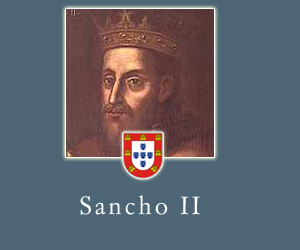
SANCHO II (1223 – 1247)
By the time of his accession to the throne, in 1223, Portugal was embroiled in a difficult diplomatic conflict with the Catholic Church. His father, Afonso II, had been excommunicated by Pope Honorius III, for his attempts at reducing the Church's power within the country. A treaty of 10 articles was signed between the Pope and Sancho II, but the king paid little attention to its fulfilment. His priority was the Reconquista, the reconquest of the southern Iberian Peninsula from the Moors. From 1236 onwards, Sancho II conquered several cities in the Algarve and Alentejo, securing the Portuguese position in the region.
Sancho II proved a capable commander but, with regard to equally important administrative issues, he was less competent. With his total attention focused on military campaigns, the ground was open for internal disputes. The nobility was displeased by the king's conduct and started to conspire against him. Moreover, the middle class of merchants quarrelled frequently with the clergy, without any intervention from the king. As a result, the Archbishop of Porto made a formal complaint to the Pope about this state of affairs. Since the Church was the super power of the 13th century, the Pope felt free to issue a Bull ordering the Portuguese to choose a new king to replace the so-called heretic.
In 1246 recalcitrant nobles invited Sancho's brother Afonso, then living in France as Consort Count of Boulogne, to take the throne. Afonso immediately abdicated from his French possessions and marched into Portugal. Sancho II was removed from the throne in 1247 and fled in exile to Toledo where he died on January 4, 1248.
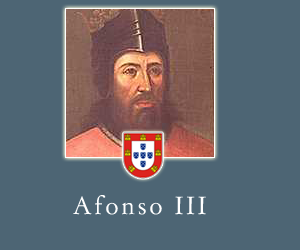
AFONSO III (1247 – 1279)
As the second son of King Afonso II of Portugal, Afonso was not expected to inherit the throne, which was destined to go to his elder brother Sancho. He lived mostly in France, where he married Matilda, the heiress of Boulogne, in 1238, thereby becoming Count of Boulogne. In 1246, conflicts between his brother, the king, and the church became unbearable. Pope Innocent IV then ordered Sancho II to be removed from the throne and be replaced by the Count of Boulogne. Afonso, of course, did not refuse the papal order and marched to Portugal. Since Sancho was not a popular king, the order was not hard to enforce; he was exiled to Castile and Afonso III became king in 1248 after his brother's death. To ascend the throne, he abdicated from the county of Boulogne and later (1253) divorced Matilda.
Determined not to commit the same mistakes as his brother, Afonso III paid special attention to what the middle class, composed of merchants and small land owners, had to say. In 1254, in the city of Leiria, he held the first session of the Cortes, a general assembly comprising the nobility, the middle class and representatives of all municipalities. He also made laws intended to restrain the upper classes from abusing the least favoured part of the population. Remembered as a notable administrator, Afonso III founded several towns, granted the title of city to many others and reorganized public administration.
Secure on the throne, Afonso III then proceeded to make war with the Muslim communities that still thrived in the south. In his reign the Algarve became part of the kingdom, following the capture of Faro—Portugal thus becoming the first Iberian kingdom to complete its Reconquista.
Following his success against the Moors, Afonso III had to deal with a political situation arising from the borders with Castile. The neighbouring kingdom considered that the newly acquired lands of the Algarve should be Castilian, not Portuguese, which led to a series of wars between the two kingdoms. Finally, in 1267, a treaty was signed in Badajoz, determining that the southern border between Castile and Portugal should be the River Guadiana.

DINIS (1279 – 1325)
As heir to the throne Infante Dinis was summoned by his father (Afonso III) to share government responsibilities. At the time of his accession to the throne, Portugal was again in diplomatic conflicts with the Catholic Church. Dinis signed a favouring agreement with the pope and swore to protect the Church's interests in Portugal. Due to this, he granted asylum to the Templar knights persecuted in France and created the Order of Christ, designed to be a continuation of the Order of the Temple.
With the Reconquista completed and the Portuguese territory freed from Moorish occupation, Dinis was essentially an administrative king, not a military one. However, a short war between Castile and Portugal broke during his reign, for the possession of the town of Serpa and Moura. After this, Dinis avoided war: he was a notably peace-loving monarch during a tempestuous time in European history. With Portugal finally recognized as an independent country by his neighbours, Dinis signed a border pact with Ferdinand IV of Castile (1297).
Dinis' main priority of government was the organization of the country. He pursued his father's policies on legislation and centralization of power. Dinis promulgated the nucleus of a Portuguese civil and criminal law code, protecting the lower classes from abuse and extortion. As king, he travelled around the country, correcting unjust situations and resolving problems. He ordered the construction of numerous castles, created new towns, and granted privileges due cities to several others. With his wife, Infanta Isabella of Aragon, Dinis worked to improve the life of the poor and founded several social institutions.
Always concerned with the country's infrastructure, Dinis ordered the exploration of mines of copper, silver, tin and iron and organized the export of excess production to other European countries. The first Portuguese commercial agreement was signed with England in 1308. Dinis effectively founded the Portuguese navy under command of a Genoese admiral and ordered the construction of several docks.
His main concern was the redevelopment and promotion of rural infrastructure, hence the nickname of "the Farmer". Dinis redistributed the land, promoted agriculture, organized communities of farmers and took personal interest in the development of exports. He instituted regular markets in a number of towns and regulated their activities. One of his main achievements was the protection of agricultural lands from advancing coastal sands, by ordering the planting of a pine forest near Leiria.
Culture was another interest of King Dinis. He had a fondness for literature and wrote several books himself, with topics ranging from administration to hunting, science and poetry. In his days, Lisbon was one of Europe's centers of culture and knowledge. The University of Lisbon (today's University of Coimbra) was founded by his decree Magna Charta Priveligiorum. He was also a great poet and troubadour.
The latest part of his peaceful reign was nevertheless marked by internal conflicts. The contenders were his two sons: Afonso the legitimate heir, and Afonso Sanches his natural son, who quarrelled frequently among themselves for royal favour. At the time of Dinis death in 1325 he had placed Portugal on an equal footing with the other Iberian Kingdoms.
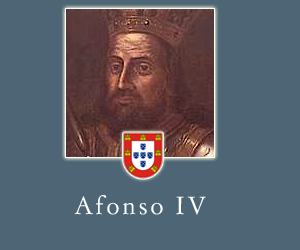
AFONSO IV (1325 – 1357)
Afonso, born in Lisbon, was his father's only legitimate son and the rightful heir to the Portuguese throne. However, he was not, according to several sources, Dinis' favourite son; his half-brother, the illegitimate Afonso Sanches, enjoyed full royal favour. From early in life, the notorious rivalry led to several outbreaks of civil war. On January 7, 1325, Afonso's father died and he became king, taking full revenge on his brother. His rival was sentenced to exile in Castile, and stripped of all the lands and fiefdoms donated by their common father. Afonso Sanches, however, did not sit still. From Castile, he orchestrated a series of attempts to usurp the crown for himself. After a few failed attempts at invasion, both brothers signed a peace treaty, arranged by the Afonso's mother Queen Elizabeth.
In 1309, Afonso IV married Infanta Beatrice of Castile, daughter of King Sancho IV of Castile by his wife Maria de Molina. The first-born of this union, Infanta Maria of Portugal, married King Alfonso XI of Castile in 1328, at the same time that Afonso IV's heir, Peter I of Portugal, was promised to another Castilian infanta, Constance of Penafiel. These arrangements were imperilled by the ill will of Alfonso XI of Castile, who was, at the time, publicly mistreating his wife. Afonso IV was not happy to see his daughter abused, and started a war against Castile. Peace arrived four years later, with the intervention of Infanta Maria herself. A peace treaty was signed in Seville in 1339 and, in the next year, Portuguese troops played an important role in the victory of the Battle of Rio Salado over the Marinid Moors in October 1340.
The last part of Afonso IV's reign is marked not by open warfare against Castile, but by political intrigue. Civil war between King Pedro of Castile and his half-brother Henry of Trastamara led to the exile of many Castilian nobles to Portugal. These immigrants immediately created a faction among the Portuguese court, aiming at privileges and power that, somehow, could compensate what they lost at home. The faction grew in power, especially after Inês de Castro, daughter of an important nobleman and maid of the Crown Princess Constance, became the lover of her lady's husband: Peter, the heir of Portugal. Afonso IV was displeased with his son's choice of lovers, and hoped that the relationship would be a futile one. Unfortunately for internal politics, it was not. Peter was openly in love with Ines, recognized all the children she bore, and, worst of all, favoured the Castilians that surrounded her. Moreover, after his wife's death in 1349, Peter refused the idea of marrying anyone other than Ines herself.
The situation became worse as the years passed and the aging Afonso lost control over his court. Peter's only male heir, future king Fernando of Portugal, was a sickly child, while the illegitimate children sired with Ines thrived. Worried about his legitimate grandson's life, and the growing power of Castile within Portugal's borders, Afonso ordered the murder of Inês de Castro in 1355. He expected his son to give in, but the heir was not able to forgive him for the act. Enraged at the barbaric act, Peter put himself at the head of an army and devastated the country between the Douro and the Minho rivers before he was reconciled to his father in early 1357. Afonso died almost immediately after, in Lisbon in May.
As king, Afonso IV is remembered as a soldier and a valiant general, hence the nickname the Brave. But perhaps his most important contribution was the importance he gave to the Portuguese navy. Afonso IV granted public funding to raise a proper commercial fleet and ordered the first maritime explorations. The Canary Islands were discovered during his reign.
Last edited:




